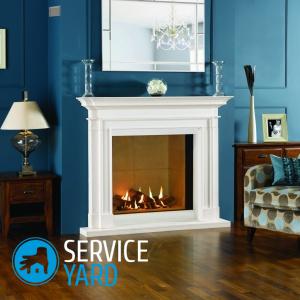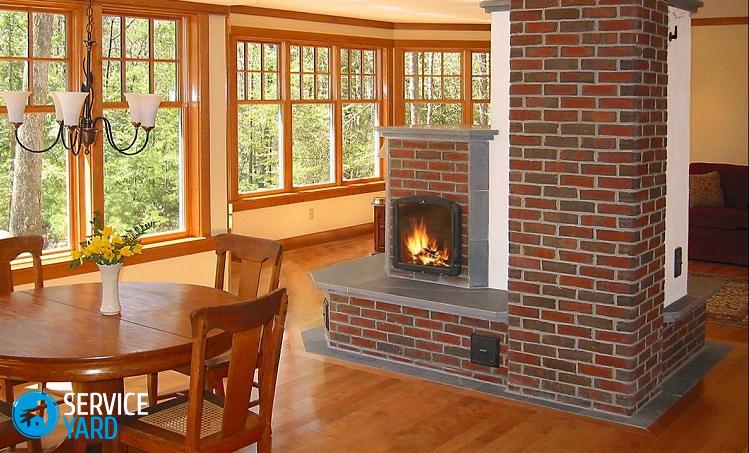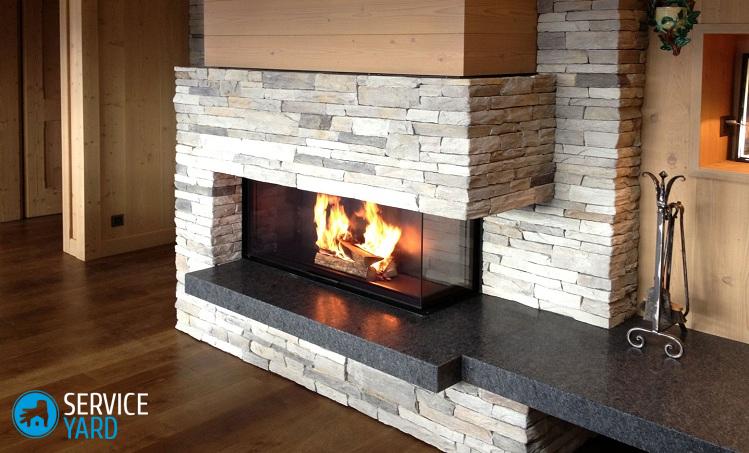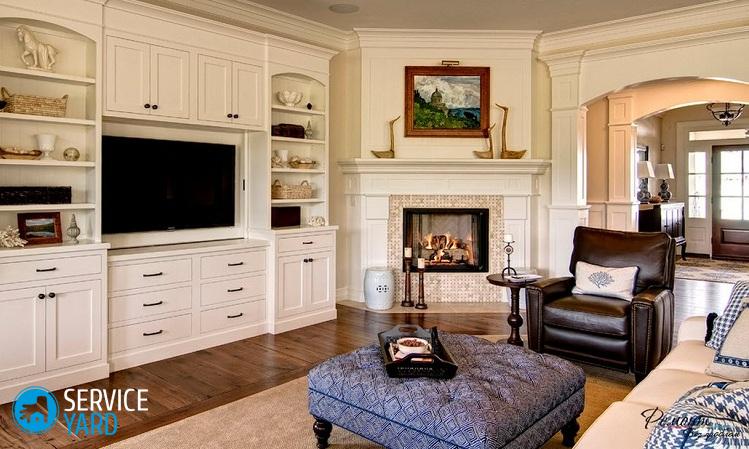Do-it-yourself fireplace made of bricks

Brick stoves and fireplaces are a stylish and popular solution for heating a home, in addition, they look very impressive and create a cozy atmosphere in the room. Currently, the modern market is represented by a huge assortment of building materials, all kinds of tools and the latest technologies, so it is not difficult to lay down a stove or a fireplace on your own. In this article we will look at how to make a fireplace with our own hands from a brick.
to contents ↑Varieties of Fireplaces
The fireplace is a brick structure in the wall that resembles a niche. It has a chimney for the exit of combustion products into the atmosphere and directly the space in which firewood is lit. Such a fireplace serves as an element of the interior, or it is used to heat the room.
Brick fireplaces are the most common and are divided into two types - built-in and wall-mounted. The difference between these species is as follows:
- Built-in fireplaces are a rather complicated installation option. They must be mounted inside the supporting wall, where the chimney is also located. Therefore, this type of fireplace should be created in advance, at the stage of developing a house project.
- Wall fireplaces are the most convenient option for self-made fireplace. Such a fireplace can be laid out in a private house or in the country, while it does not require much experience. You can build such a fireplace at any time - both in the finished room, and during the construction of the house itself.
to contents ↑Important! If you plan to lay in a residential building, where repairs have already been completed, then in order to create a separate foundation for installing a stove or fireplace, you will have to tinker a bit.
Choosing the size and shape of the fireplace
For any construction work, the initial stage is the creation of a project. Before you lay out the fireplace, you should decide on the dimensions and shape of the fireplace, since both the appearance of the hearth and the safety of the residents of the apartment depend on them.
Standard brick dimensions, room dimensions, classic proportions affect the size of the fireplace. In order to determine the most optimal sizes and make a brick fireplace with your own hands, it is necessary to perform such actions:
- We determine the dimensions of the furnace. To do this, you need to measure the area of the room and divide the value by 100. For example, a living room with an area of 30 square meters requires a combustion chamber area corresponding to 0.3 meters.
- Determine the depth of the shelf. The depth value should be 1.5-2.5 times less than its width. So, for example, if we select a furnace area of 0.3 meters and the ratio of depth to width is 1.2, then the depth value is 37.5 cm, which corresponds to one and a half bricks, and with a width of 75 cm - three bricks are needed.
- We calculate the height of the shelf. The height should be 1.5 times the width. So, for example, for a shelf with a width equal to three bricks, the height will be slightly more than a meter, while laying out 14-15 rows of bricks.
- We calculate the parameters of the chimney. An important parameter is the determination of the area of the chimney hole, which should refer to the area of the shelf in accordance with 1 to 10 or 1 to 15. The width of the chimney may be slightly larger, but the height of the straight section should be in the range of 3 to 5 meters.If this correspondence is not maintained, it will be very difficult to achieve traction stability.
to contents ↑Important! It is much easier to use ready-made drawings of fireplaces made of brick. Then you will get rid of self-drawing layouts and you will not have unpleasant surprises when kindling.
How to lay a corner fireplace?
The corner brick fireplace is mainly built in a small living room or bedroom. Being in the corner of the room, such a center occupies a minimal area, due to which space is significantly saved, uniform dissipation of thermal energy into the interior of the room occurs, and the room is effectively heated. A neatly laid out corner hearth, without smoke and defects, is not so much a heating fireplace as a decorative and presentable element of a house. The positive side of corner fireplaces is that they have strong traction, as a result - they quickly melt and immediately radiate heat into the apartment.
Important! For the manufacture of corner fireplaces, you should choose only the material of the right brand - if you use substandard brick with cracks or unevenly burnt, then your fireplace will turn into an ugly array, or your room will be constantly smoky.
For laying a corner fireplace, it is necessary to create a separate foundation and fire-fighting cutting between wooden surfaces and a brick massif. For separation, metal sheet or brickwork corresponding to a quarter of the brick is mainly used.
On the Internet there are many ready-made ordering schemes. Consider a masonry diagram of a corner brick fireplace with your own hands with dimensions of 1x1 meter.
Necessary materials:
- for the outer walls you need 200 pieces of ceramic red brick;
- for the manufacture of the furnace 100 pieces of refractory bricks are used;
- sand;
- clay;
- cement;
- concrete for the foundation.
Helpful hints:
- If additional decorative cladding is required during the laying process, then you can use artificial or natural natural stones, ceramic tiles, tiles and other materials.
Important! It is recommended that the stones be varnished on top, thus improving their decorative properties and facilitating maintenance.
- The simplest and cheapest way of facing is plaster, which is used after the masonry shrinks. Using various spatulas, you can create a variety of decorative effects on the plaster. You can also use the coloring of the plaster.
- Another popular way of facing a corner fireplace is the use of drywall. This material is cut and attached to a special metal frame, while strictly checking the walls and corners with a level.
How to lay an English fireplace?
For large spacious rooms in a classic style, it is preferable to install an English solid hearth. To lay out such a fireplace, you must have some experience with brickwork and step by step to carry out the points of the proposed scheme.
Materials for work
To make a fireplace, you need to prepare the following materials and tools in advance:
- ceramic brick of red color in the amount of 300 pieces, the brand should not be lower than M200;
- 130 pieces of fireclay bricks;
- crushed stone with a size of 2 to 6 mm;
- Portland cement;
- a pair of bags of oven clay or refractory masonry mixture;
- quarry sand about 4 bags;
- one bag of cement;
- steel corners and fittings;
- stove door, through which the chimney is cleaned;
- metal corner and steel strip, which correspond to 3 segments of one meter;
- screen;
- spark arrester, which is a nozzle for protection against fire in the form of a cone;
- a deflector for a pipe that protects from wind and serves to enhance traction;
- hammers;
- level;
- Master OK;
- grate;
- waterproofing material which can be used, for example, roofing material;
- facing materials.
Important! The masonry methods of all fireplaces are very similar to each other, so we will consider one of the difficult options for the independent manufacture of a brick fireplace, which is the English hearth.
Foundation making
In order to make a fireplace with your own hands made of bricks, first you need to fill the foundation. The foundation of the fireplace has certain requirements:
- The stability of the fireplace is affected not only by the masonry, but also by the reliability of the hearth base. Therefore, it is necessary to fill in the foundation for the outbreak separately from the foundation of the structure.
Important! If you ignore this recommendation, the occurrence of seasonal soil shifts can cause damage to the fireplace and chimney.
- If it is planned to place the hearth on the wall, which is the bearing, then between the strip foundation of the building and the base of the fireplace make a compensation pillow of sand. At the same time, sand is poured between the foundations, after which it is spilled with water.
- The base must be so high that the first row of masonry matches the level of the finishing floor.
- A dug foundation pit does not have to be deep. If heaving soil is present, then a gravel-sand cushion with a thickness of not less than half a meter is mandatory.
- The presence of sand and gravel can compensate for soil shifts, prevent the capillary rise of water from it and prevent the walls of the fireplace and the foundation itself from being waterproofed.
- For pouring the foundation, concrete of the M150-M300 brand is used, while reinforcement is mandatory.
- For the manufacture of formwork, plywood or boards are used, fastening the boards with self-tapping screws.
- When pouring the foundation, the size of each of its sides should be 10 cm larger than the dimensions of the fireplace. The developed drawings made of bricks have all the dimensions necessary for pouring the foundation, so it is quite possible to use them.
- After completion of the foundation pouring, it is necessary to withstand about 6-7 days so that the concrete can gain critical strength, only after that it is permissible to proceed to marking and laying the fireplace.
- Prior to masonry, additional waterproofing should be created, while laying out a double layer of roofing material.
- Before the installation process, the wall behind the fireplace must be insulated with a dense foil or metal sheet.
- Present wooden structures should be additionally treated with a solution for internal work, which includes flame retardant.
- The front of the fireplace should be decorated with a refractory coating to prevent the possible ingress of small coals of sparks.
- Before starting the masonry process, it is required to sort the bricks, laying aside those that have chips and cracks. Damaged bricks can be used for laying the foundation.
Important! Before starting the masonry, the red ceramic brick should be soaked briefly in water. While refractory bricks should never be wetted - all dirt and dust from its surface can be wiped off with a damp cloth. Thanks to this procedure, the masonry mortar is uniformly dried.
Order for the English hearth
Consider the order with explanations for making an English brick fireplace with your own hands:
- Rows 1 and 2 are the base of the fireplace and are made of solid red bricks, while the area is expressed 1140 by 1270 mm and corresponds to two rows of masonry with dressing. Before starting the masonry, the foundation is checked according to the level - in the presence of small irregularities, the foundation can be adjusted by increasing the thickness of the seam. For laying the foundation, a cement-sand mortar is used, while the ratio of 1 to 2 or 1 to 3 should be maintained.
Important! In order not to get confused during the manufacturing of a brick fireplace, it is advisable to number each row of masonry with chalk.
- Rows 3 and 4 are performed similarly to the previous rows, only in the 4th row they lay refractory bricks on a fire-resistant solution.
Important! Try to maintain the ratio of clay and sand, while the mixed solution should not adhere too much to the spatula or trowel, but, at the same time, should not slip from it during operation.
- The next step in laying the fireplace is to make the walls of the shelf. They are performed using order. Refractory bricks on clay mortar are used for the inner walls. The external walls are laid out of ceramic brick on a cement-sand mortar, or you can use a mixture of clay and sand, while adding 10-20% of the cement.
- The bricks that form the rear corners of the shelf must be cut off diagonally with a grinder. Due to this form of the furnace, better heat transfer occurs.
- In the 12th row from above, the masonry is framing, applying a corner and a steel strip. In the back of the 12th row, a bonded masonry of brick is used, cut at an angle so that a vault is formed.
- From the 13th to the 16th rows, a fireplace vault and a gas tooth are formed. In the upper front part there is a protrusion that prevents reverse draft and the possibility of smoke entering the room.
- In the 15th row, a narrowing of the chimney is formed, in which an increased smoke pressure is observed and increased draft occurs. Then the chimney expands.
- In the 16th row, we build in a cleaning door through which accumulated soot will be removed. For laying the inner surface of the chimney, chamotte brick is used, the outer surface is made of red ceramic brick.
- Next, lay out the gradually narrowing chimney and chimney. At the same time, they try to rub the seams thoroughly from the inside, after which they are wiped with a damp cloth to remove residual solution.
Important! If at least some roughness occurs on the walls of the chimney, then soot will accumulate in this place.
- The last step is to lay out the chimney of the fireplace. Gradually narrow the lumen of the pipe and thus reach one brick, after which they are blocked in the 25th row by a damper. A brick pipe is made of the required height.
- For 4-5 days, the fireplace is dried at room temperature. Then, slowly they begin to drown, while there is uniform heating and sintering of the clay solution, from which the furnace is laid out. This procedure helps to avoid crumbling and extends the life of the fireplace.
- After completion of the laying and heating process, you can proceed to the finishing work.
to contents ↑Important! When cutting bricks, be sure to use protective equipment for the respiratory tract and eyes from dust - for this there are gauze dressings and construction glasses.
Stock footage
In this article, we examined in detail the scheme of laying a brick fireplace with our own hands. As you should have understood, if there are a lot of subtleties and nuances, the solution of which requires appropriate practical construction experience. And since the fireplace is an unsafe structure, in the absence of knowledge and skills in working with bricks and mortars, it is better to enlist the help of specialists in this matter.
- How to choose a vacuum cleaner taking into account the characteristics of the house and coatings?
- What to look for when choosing a water delivery
- How to quickly create comfort at home - tips for housewives
- How to choose the perfect TV - useful tips
- What to look for when choosing blinds
- What should be running shoes?
- What useful things can you buy in a hardware store
- Iphone 11 pro max review
- Than iPhone is better than Android smartphones






